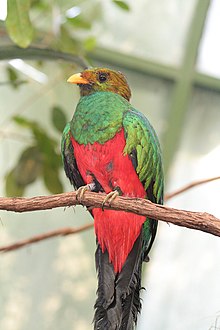Quetzal
| Quetzal | |
|---|---|

| |
| Golden-headed quetzal | |
| Scientific classification | |
| Domain: | Eukaryota |
| Kingdom: | Animalia |
| Phylum: | Chordata |
| Class: | Aves |
| Order: | Trogoniformes |
| Family: | Trogonidae |
| Groups included | |
| |

Quetzals (
Physical attributes
Quetzals have iridescent green or golden-green
Conservation status
None of the many quetzal species are under immediate threat in the wild, although the eared and resplendent quetzal are at the
Etymology
The name quetzal is from Nahuatl quetzalli [keˈt͡salːi], "large brilliant tail feather" (American Audubon Dictionary) or "tail coverts of the quetzal" (Merriam-Webster's Collegiate Dictionary), from the Nahuatl root quetz = "stand up" used to refer to an upstanding plume of feathers. The word entered English through Spanish. The quetzal plays a central role in Mesoamerican mythology and is associated with the Aztec deity Quetzalcoatl.
The word quetzal was originally used for just the
Pharomachrus is from Ancient Greek φάρος pharos, "mantle", and μακρός makros, "long", referring to the wing and tail coverts of the resplendent quetzal (the second h is unexplained).
The quetzal is also known in Peru as the pilco.[12][13]
Cultural significance
The Quetzal has long been significantly important for the ancient Maya and Aztecs. Their feathers were considered luxury goods to represent high status and are often seen in the headdresses of the emperors and other costume elements.[6]
Species
Genus Pharomachrus:
- Crested quetzal, Pharomachrus antisianus.
- Golden-headed quetzal, Pharomachrus auriceps.
- White-tipped quetzal, Pharomachrus fulgidus.
- Resplendent quetzal, Pharomachrus mocinno.
- Pavonine quetzal, Pharomachrus pavoninus.
Genus Euptilotis:
- Eared quetzal, Euptilotis neoxenus.
- American Ornithologists' Union, but the eared trogon by others.
See also
- List of English words of Nahuatl origin
- The Nest (aviary)
References
- . Retrieved 11 November 2021.
- S2CID 237505997.
- ^ ISBN 0-7136-7242-0(vol. 2).
- ^ ISBN 0-691-08529-3
- OCLC 7793011322.
- ^ ISSN 0300-7839.
- . Retrieved 11 November 2021.
- S2CID 2329738.
- ^ "Rutas de observación". Observación del Quetzal en Guatemala (in Spanish). INGUAT. 2009. Retrieved 28 December 2022.
- S2CID 202847057.
- S2CID 86242565.
- ^ Sclater, Philip Lutley (1859). "List of the first Collection of Birds made by Mr. Louis Fraser at Pallatanga, Ecuador, with Notes and Descriptions of New Species". Proceedings of the Zoological Society of London. XXVII: 144.
- ^ "Pilco o Quetzal Cabeza Dorada" (in Spanish). Parque Nacional de Perú. 2006. Retrieved 2017-09-07.
External links
- "Pharomachrus". Integrated Taxonomic Information System.
- Trogon videos, including quetzals, on the Internet Bird Collection
- A study about quetzal, The quetzal description and habitat
